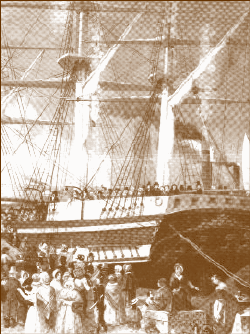|
The
Journey Was Difficult
Many Did Not Survive the Trip Across the Ocean
During the 18th and
into the 19th century, immigrants who finally planted their feet on American soil were
lucky to have survived the perils of the voyage. Anxious to encourage settlement of the
West, agents promoted immigration to greedy ship lines who then packed as many travelers
as they could on each boat.
Prior to 1848, not only would immigrants have to load their
own belongings, but families would be required to bring along food for the voyage. There
was no one to advise the immigrants as to whether or not these rations would be adequate
for the trip.
In the days of sailing ships, crossing the Atlantic Ocean was a slow and frequently
dangerous experience. The overcrowded boats were at t he mercy of the ocean and the
weather, dependent upon the wind belts for propulsion. On a calm sea with little wind, the
sails would hang useless and a trip across the ocean could take on average from one to
three months. he mercy of the ocean and the
weather, dependent upon the wind belts for propulsion. On a calm sea with little wind, the
sails would hang useless and a trip across the ocean could take on average from one to
three months.
Even wealthier passengers suffered when the sea conditions were rough, and generally
traveled in overcrowded conditions. The ‘first class’ cabins were small,
cramped, narrow and dark but were elegant compared to where the poorer emigrants stayed.
They were literally packed together in a dark part of the vessel, with meager food rations
and little room to move.
The transportation of African-Americans hit a ‘boom’ period after 1660 when
the plantation system in South Carolina, Virginia and Maryland created a demand for
service labor. By 1740, the slavery system in
colonial America was fully developed. Considered to be "chattel...in the hands of
their owners and possessors..." blacks suffered greatly on the journey, coming
over on vessels of one to two hundred tons that carried 400 to 500 people, as well as the
crew and the provisions. Men, women and children of all ages were transported, enduring
very harsh traveling conditions, starvation rations and captivity.

Disease was rampant in these
crowded circumstances, with the ill and the healthy immigrant packed tightly together.
Fatalities from disease and ships lost at sea frequently ranged from 10% to 15%. Early
18th century horror stories place deaths as high as 50% of a ship’s passengers. A
1750 voyager described his six-month sea journey as "...stench, fumes, horror,
vomiting, many kinds of seasickness, fever, dysentery, headache, heat, constipation,
boils, scurvy, cancer, mouth-rot, and the like, all of which came from old and sharply
salted food and meat, also from very bad and foul water, so that many die miserably."
In
1842, Charles Dickens, a famous English writer who wrote extensively about the plight of
the poor in England, visited America. He experienced first-hand the terrible conditions
that prevailed for immigrants aboard passenger ships headed for the new world. In his
"American Notes" he records the conditions immigrants suffered, dressed in rags
and destitute after selling their belongings to pay for their passage. Depending on others
for food, lacking medical treatment they lived in packed, unsanitary conditions for the
duration of the voyage.
He states, that, "Above all, it is the duty of any government, be it monarchy
or republic to interpose and put an end to the system by which a firm of traders in
emigrants purchase of the owners the whole ‘tween-decks’ of a ship and send on
board as many wretched people as they can lay hold of, on any terms they can get, without
any reference to the convenience of the steerage, the number of berths, the
slightest separation of the sexes, or anything but their own profit. Nor is this the worst
of this vicious system; for certain crimping agents of these houses, who have a percentage
on all the passengers they inveigle are constantly traveling about those districts where
poverty and discontent are rife and tempting the credulous into more misery, by holding
monstrous inducements to emigrate which can never be realized."
Desperate immigrants created many opportunities for abuse by the ‘less than
ethical’ ship owners. The Scotch-Irish, who were facing the prospect of starvation in
their home country, would often sell themselves to the ship’s captain for the cost of
their passage. Once they reached the ‘New World’, the captain would auction off
their services, with the immigrant working a term of years in ‘slave-like’
environments such in sweatshops, etc.
It took a long time for these conditions to change, in spite of the federal government
enacting legislative limits on the number of passengers per ship, etc. The boat owners got
around these restrictions by growing the unregulated travel in ‘steerage’.
"On the boat we came in steerage. Third class was plain steerage...they piled us
up eight or ten people in one cabin, and the food was the worst that it could be."...Emigrant
from Czechoslovakia in 1920.
With the use of the steamship in the early part of the 19th century, the ocean voyage
time was cut to less than two weeks, contributing to the successful arrival of more
immigrants. Now a quicker and safer voyage, most of the immigrants were able to survive
even very unpleasant conditions to complete the journey.
'Immigration'
segment written in November, 1997 by David
Lodge
[ Back to Immigration Index ]
|

